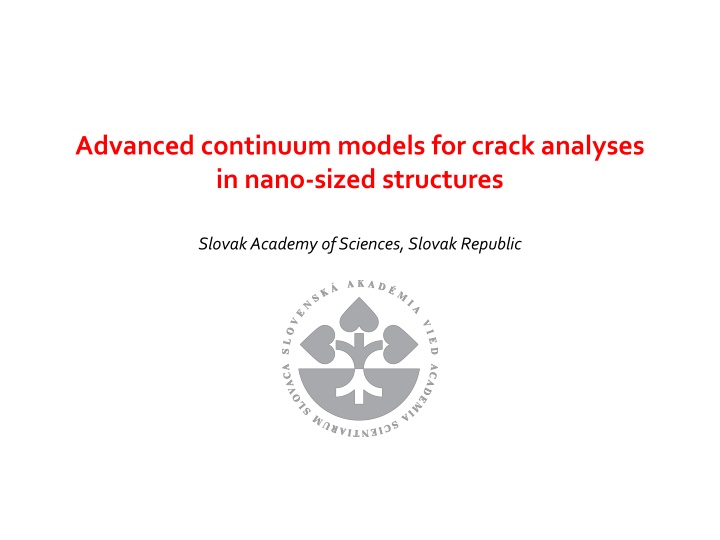
Flexoelectricity in Nano-sized Structures: Advanced Analyses and Practical Applications
Explore the fascinating concept of flexoelectricity in nano-sized structures, where strain gradients induce polarization, leading to size-dependent material properties. Practical applications include health monitoring and crack detection in structural elements. Discover the latest research findings and publications in this field.
Download Presentation

Please find below an Image/Link to download the presentation.
The content on the website is provided AS IS for your information and personal use only. It may not be sold, licensed, or shared on other websites without obtaining consent from the author. If you encounter any issues during the download, it is possible that the publisher has removed the file from their server.
You are allowed to download the files provided on this website for personal or commercial use, subject to the condition that they are used lawfully. All files are the property of their respective owners.
The content on the website is provided AS IS for your information and personal use only. It may not be sold, licensed, or shared on other websites without obtaining consent from the author.
E N D
Presentation Transcript
Advanced continuum models for crack analyses in nano-sized structures Slovak Academy of Sciences, Slovak Republic
Flexoelectricity ???,? ?? ????????,? The presence of strain gradients may potentially break the inversion symmetry and induce polarization even in centrosymmetric crystals (direct effect). The flexoelectric effect is the consequence of the coupling of the large strain gradients and the electric polarization in dielectric materials. The flexoelectric effect is the size dependent material property. The practical utilization of research results can be used, for example, in health monitoring structures (prevention of catastrophic accidents) or in the detection of microcracks in structural elements.
Flexoelectricity Javvajiet al., Nanotechnology, 29, 2018225702 The flexoelectric effect observed by the non-uniform straining of a graphene nanoribbon, which is a manifestly non-piezoelectric material The variation of polarization ?? ???,?for graphene sheet with triangular defect. Solid lines represent the linear fitting between them. ?with
Flexoelectricity 2 nm Wang et al., Nano Letters, 20, 1, 2020 Displacement vector map between the TiOand Sr columns overlaid with the scanning transmission electron microscopy. The big yellow arrow highlights the interfacial SrOplane between SrMnO3and SrTiO3 The red arrows highlights polarization observed in a region about 3 4 unit cells surrounding the crack tip. The strain gradients usually occur near the crack tip and therefore it is relevant to suppose that the crack formation and propagation is affected by the flexoelectricity in the dielectric materials.
Flexoelectricity The constitutive equations flexo(?? ? coupling) indirect piezo (? ? coupling) strain gradient elasticity ???= ???????? ?????? ???????,? ????= ???????+ ??????????? ??= ?????+ ???????+ ????????? flexo(?? ?coupling) direct piezo (? ? coupling) ???= ????????+ ??????,? higher-grade polarization It is well-known that classical continuum mechanics neglects the interaction of material microstructure, and the results are size-independent. It is necessary to employ a more appropriate and reliable size-dependent theory of piezoelectricity in which higher gradients of deformation and electric intensity vector are considered.
Results Publications 1. J. Sladek, V. Sladek, X.Tian, Q. Deng: Mixed FEM for flexoelectric effect analyses in a viscoelastic material. International Journal of Solids and Structures, 234-235 (2022) 111269. J. Sladek, V. Sladek, S.M. Hosseini: Analysis of a curved Timoshenko nano-beam with flexoelectricity, Acta Mechanica232 (2021) 1563-1581. X. Tian, J. Sladek, V. Sladek, Q. Deng, Q. Li: A collocation mixed finite element method for the analysis of flexoelectric solids. International Journal of Solids and Structures, 217-218 (2021) 27-39. J. Sladek, S. Hocker, H. Lipp, V. Sladek, Q. Deng: Atomistic approach for the evaluation of direct flexoelectric coefficients in gradient theory, Ferroelectrics569 (2020) 182-195. X. Tian, M. Xu, Q. Deng, J. Sladek, V. Sladek, M. Repka, Q. Li: Size-dependent direct and converse flexoelectricity around a micro-hole. Acta Mechanica231 (2020) 4851-4865. J. Sladek, V. Sladek, M. Wunsche, Ch. Zhang: Effects of electric field and strain gradients on cracks in piezoelectric solids. European Journal of Mechanics/A Solids 71 (2018) 187 198. J. Sladek, V. Sladek, M. Repka, E. Pan: Size effect in piezoelectric semiconductor nanostructures. Journal of Intelligent Materials Systems and Structures 33 (2022) 1351-1363. J. Sladek, V. Sladek, X.Tian, Q. Deng: Mixed FEM for flexoelectric effect analyses in a viscoelastic material. International Journal of Solids and Structures, 234-235 (2022) 111269. X. Tian, M. Xu, H. Zhou, Q. Li, J. Sladek, V. Sladek: Analytical studies on mode III fracture in flexoelectric solids. ASME Journal of Applied Mechanics 89(4) (2022) 041006. 10. T. Profant, J. Sladek, V. Sladek, M. Kotoul, Asymptotic solution for interface crack between two materials governed by dipolar gradient elasticity: Amplitude factor evaluation. Theoretical and Applied Fracture Mechanics 120(8) (2022) 103378. 2. 3. 4. 5. 6. 7. 8. 9.
Results Examples Variation of the out-of-plane displacement on the upper crack surface (? = ?) of Mode III cracks. Variation of the out-of-plane electric polarization on the upper crack surface (? = ?) of Mode III cracks..
